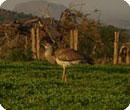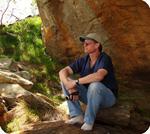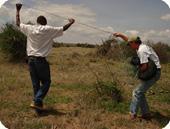Catching Koris in Kenya
By Stephen Schulze, Keeper at the National Zoo’s Small Mammal House
Bustard populations across the world are in decline, including those of kori bustards, the heaviest of all flighted species of bird. This past autumn, I was privileged to join a National Zoo team that travelled to Kenya to continue a long-term field study of these amazing birds. Our mission was to conduct a biomedical survey, briefly trapping wild koris in order to collect blood and fecal samples, take body measurements and weights. Such data contribute to a baseline understanding of what a healthy wild kori looks like, and give scientists and animal keepers a better gauge of not only what is happening in the wild, but also how to improve the husbandry of captive populations.
The Zoo team consisted of three members: Rhea Hanselmann, a Smithsonian fellow and the study's de facto leader, Katharine Hope, one of the Zoo's clinical veterinarians, and me, an animal keeper with a fair amount of experience in wrangling captive exotics. Sara Hallager, the Zoo's resident expert on kori bustards, a biologist at the Bird House, and the only one of us with experience catching them in the wild, had to opt out of the trip for urgent knee surgery.
Roughly three hours north of Nairobi, right on the equator, is the charmless town of Nanyuki, the supply hub of the area. From its center we turn sharply west, toward our ultimate destination: Mpala. Mpala is a wildlife conservancy of 48,000 acres, closely affiliated with Princeton University and the Smithsonian Institution, and dedicated to the support of scientific field research.
The setting is gorgeous, poised on the southwestern rim of the Rift Valley. Mount Kenya looms to the east, with its spiking tower of a peak, more often than not shrouded in clouds. Volcanic escarpments rise in bands to the west, and that is where koris are most likely to be found. We are housed in bandas, traditional circular dwellings, usually a single room, with high thatched roofs resembling beehives. The rear window of my banda looks out on a series of circular stone walls, built to protect the tops of cisterns from the tread of elephants. Families of rock hyraxes live in these walls, and can be seen sunning themselves in the morning, provided one doesn't move suddenly or make noise.
Koris are not easy to catch. Trapping a bird takes team coordination, speed, and stealth. The method works out something like this: After spotting a likely bird, string up a monofilament gil net nine feet high and a football field long, using only natural vegetation to support it. And, as acacia trees are the only natural vegetation available, we use them exclusively. String the net quickly, silently, and invisibly.
Of paramount importance is the orientation of the net to the sun: perpendicular is best, with the sun behind the bird. Circle around the bird, also quickly, silently, and invisibly. If you prove stealthy and lucky enough to creep within striking distance, gun the engine all at once and drive like a lunatic from The Road Warrior, zigzagging to confound the bird, and run it into the net. Leap from the vehicle, though it might still be in motion, to secure the entangled bird. Untangle it safely and enfold it in your arms. Talk soothingly, in whispers, while the bird attempts to tear your arms off in its efforts to kick free. Hope that someone slides the hood quickly over its eyes, and that the hood has a calming effect. Pray that you have remembered to bring all the necessary syringes, vials, bags, scales—in short, the whole infirmary.
Before we can employ these exemplary techniques, we need to actually find a likely bird. For several days, we string up the net again and again in vain. We spend more time extricating the mesh from acacia thorns than we do on anything else, apart from waiting. The koris of Mpala have proved unexpectedly elusive. Oh, we see them. But for nearly a week we fail to catch one.
Finally, we net our first bird, and it's nearly a textbook capture. Antony, our guide, leaps from the vehicle and is the first to lay hands on it, but allows me to show him the proper restraining techniques. (I decline to jump from behind the wheel while the vehicle is still in motion, thank you.) This is the one and only instance that I restrain a wild kori, demonstrating how the arms should form a living cage, expanding and contracting as the bird breathes, and how the torso is used to pin the bird while applying minimal weight. Antony gets it instantly, and any further opportunities will be his.
Once Rhea and Katharine have finished taking blood, and swabs, and measurements, and notes, they fasten a leg band. Everyone takes position behind the bird, keeping silent and low to the ground to be less threatening. The bird is unhooded, and pointed away from all barriers, and allowed to regain the stability of her legs before hands spring away to free her.
To our surprise, she doesn't flee in a panic, or even take flight, but struts off in an almost stately manner, gronking (a guttural growl, a bark kept in the throat), as though to show umbrage over her soiled dignity. She has lifted six pummeled spirits off of the dusty ground, and takes with her our gratitude and admiration.
This story was originally published in the April 2010 issue of Between the Lions, Friends of the National Zoo’s volunteer newsletter. Find out about volunteering at the Zoo.
Related Species:





